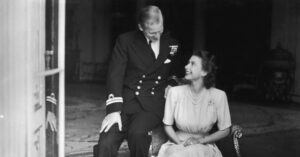:max_bytes(150000):strip_icc():format(jpeg)/queen-elizabeth-prince-philip-engagement-getty-recirc-1224-3b7c268cd1a34ba18a7552cca21a84b6.jpg)
Queen Elizabeth II and Prince Philip, the Duke of Edinburgh, had the longest royal marriage in history; they were wed for 73 years, from 1947 up until Philip’s death in April 2021. The queen famously referred to her husband as her “strength and stay” in 1997—something we’d argue she knew from the moment her feelings deepened towards him in 1946, the year of their courtship and (secret) engagement.
The pair had known each other since Elizabeth’s childhood (there was a five year age gap between them), during which she harbored a schoolgirl’s crush on the exiled prince. Philip, the son of Prince Andrew of Greece and Princess Alice of Battenberg, had left his homeland when he was just 18 months old, after his father was accused of treason; he spent much of his early life moving between countries before he settled in England—and joined the Royal Navy ahead of World War II—towards the latter part of his teenage years.
His royal birth, however, ensured that his and Elizabeth’s paths crossed several times—and when the future queen reached her 20s, their relationship (which had mainly consisted of friendly letters sent during the war that Philip would occasionally “deign to reply,” per a 1957 feature in Time) changed. She affirmed to her father, King George VI, that Philip was “the only man I could ever love.” Elizabeth—whose life and legacy was irrevocably altered when her uncle, King Edward VIII, abdicated the British throne when she was 10, a decision that positioned her as an unexpected heir—was adamant in her choice.
Central Press / Stringer / Getty Images
Her family, however, was skeptical. Philip’s marriage proposal didn’t involve him gaining resoundingly enthusiastic permission from the king; in fact, Elizabeth’s father needed convincing that his daughter’s match to a relatively penniless prince, who had been exiled from his own land, would not be deleterious to her future rule. “The King and Queen were appalled,” Lady Pamela Hicks, the daughter of Lord Louis Mountbatten, Philip’s uncle, told Vanity Fair in 2013. The media, however, had a field day; when Philip and Elizabeth were photographed looking cozy at Hicks’ sister’s wedding (he helped her out of her jacket!), the press got printing, which resulted in a 64 percent approval rating for their marriage, per Newsweek.
Still, the king had a few conditions when Philip came to him for his daughter’s hand: He needed to become a naturalized British citizen and Elizabeth needed to wait until her 21st birthday before officially announcing the news. As for how the proposal unfolded? Though we don’t have the specifics, it’s widely recognized that the future consort gained approval from George (who granted said conditional permission) in the summer of 1946. Philip, prepared with a diamond engagement ring made from the gemstones of one of his mother’s tiaras, got down on one knee at Balmoral (the queen’s favorite place) after a month-long summer holiday at the Scottish castle with the royal family.
Philip was ecstatic, and said as much in a letter to his bride-to-be shortly after popping the question: “I am sure I do not deserve all the good things which have happened to me. To have been spared in the war and seen victory…to have fallen in love completely and unreservedly, makes all one’s personal and even the world’s troubles seem small and petty.”
Hulton Deutsch / Contributor / Getty Images
As promised, the pair kept their intention to wed a secret until the following year, and formally announced their engagement on July 9, 1947 (a few short months after the queen’s birthday). The pair was married four months later, in a televised ceremony held at Westminster Abbey that drew millions of viewers—and kicked off the couple’s 73-year-long marriage that’s hailed as one of the most remarkable unions of our age.
